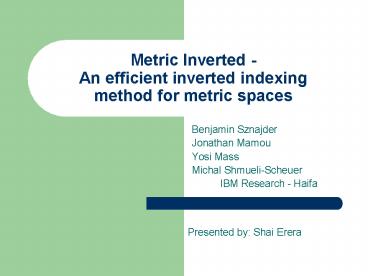Metric Inverted - An efficient inverted indexing method for metric spaces - PowerPoint PPT Presentation
1 / 25
Title:
Metric Inverted - An efficient inverted indexing method for metric spaces
Description:
Invert objects (canonization to lexicon terms) Metric inverted indexing ... Canonization map features (Fi:vi) ... Canonization. For each feature select the n ... – PowerPoint PPT presentation
Number of Views:122
Avg rating:3.0/5.0
Title: Metric Inverted - An efficient inverted indexing method for metric spaces
1
Metric Inverted -An efficient inverted
indexingmethod for metric spaces
- Benjamin Sznajder
- Jonathan Mamou
- Yosi Mass
- Michal Shmueli-Scheuer
- IBM Research - Haifa
Presented by Shai Erera
2
Outline
- Motivation
- Problem Definition
- Metric Inverted Index
- Retrieval
- Experiments
- Conclusions
3
Outline
- Motivation
- Problem Definition
- Metric Inverted Index
- Retrieval
- Experiments
- Conclusions
4
Motivation
- Web 2.0 enables mass multimedia productions
- Still, search is limited to manually added
metadata - State of the art solutions for CBIR (Content
Based Image Retrieval) do not scale - Reveal linear scalability in the collection size
due to large number of distance computations - Can we use textIR methods to scale up CBIR?
5
Outline
- Motivation
- Problem Definition
- Metric Inverted Index
- Retrieval
- Experiments
- Conclusions
6
Problem definition
- Low level image features can be generalized to
Metric Spaces - Metric Space An ordered pair (S,d) , where S is
a domain and d a distance function d S x S ? R
such that - d satisfies non-negativity, reflexibility,
symmetry and triangle inequality - The best-k results for a query in a metric space
are the k objects with the smallest distance to
the query - Convert distances to scores (small distance
high score) between 0,1
7
Problem definition
- Top-K Problem
- Assume m metric spaces, a Query Q, an aggregate
function f and a score function sd() - Retrieve the best k objects D with highest
f(sd1(Q,D), sd2(Q,D)sdm(Q,D))
k5
8
Outline
- Motivation
- Problem Definition
- Metric Inverted Index
- Retrieval
- Experiments
- Conclusions
9
Metric Inverted Index
- Assume a collection of objects each having m
features - Object D F1v1, F2v2,, Fmvm
- m metric spaces
- Indexing steps
- Lexicon creation (select candidates)
- Invert objects (canonization to lexicon terms)
10
Metric inverted indexing Lexicon creation
- Number of different features too large
- Need to select candidates
- Naïve solution
- Lexicon of fixed size l
- Select randomly l/m documents and extract their
features - These l features form our lexicon
- Improvement
- Replace the random choice by clustering (K-Means
etc.) - Keep the lexicon in an M-Tree structure
11
Metric inverted indexing invert objects
- Given object D F1v1, F2v2,, Fmvm
- Canonization map features (Fivi) to lexicon
entries - For each feature select the n nearest lexicon
terms - D F1v11, F1v12, F1v1n, F2v21,
F2v22, F2v2n, Fmvm1, Fmvm2,
Fmvmn - Index D in the relevant posting-lists
12
Outline
- Motivation
- Problem Definition
- Metric Inverted Index
- Retrieval
- Experiments
- Conclusions
13
Retrieval stage term selection
- Given Q F1qv1, F2qv2,, Fmqvm
- Canonization
- For each feature select the n nearest lexicon
terms - Q F1qv11, F1qv12, F1qv1n,
F2qv21, F2qv22, F2qv2n,
Fmqvm1, Fmqvm2, Fmqvmn
14
Retrieval stage Boolean Filtering
- These mn posting-lists will be queried via a
Boolean Query - Two possible modes
- Strict-query-mode
- Fuzzy-query-mode
15
Retrieval stage Scoring
- Documents retrieved by the Boolean Query are
fully scored - Return the best k objects with the highest
aggregate score - f(sd_1(Q,D),sd_2(Q,D), ,sd_m(Q,D))
16
Outline
- Motivation
- Problem Definition
- Metric Inverted Index
- Retrieval
- Experiments
- Conclusions
17
Experiments
- Focus on
- Efficiency
- Effectiveness
- Collection of 160,000 images from Flickr
- 3 features are extracted from each image
- EdgeHistogram, ScalableColor and ColorLayout
- 180 queries Fuzzy-Query-Mode
- Sampled from the collection of images
- Compared to M-tree data-structure
18
Experiments Measures Used
- Effectiveness MAP is a natural candidate for
measuring - Problem In Image Retrieval, no document is
irrelevant - Solution we defined as relevant the k highest
scored documents in the collection (according to
the M-Tree computation) - MAP_at_K MAP computed on relevant and retrieved
lists of size k
19
Experiments Measures Used contd.
- Efficiency we compute the number of computations
per query - A computation unit (cu) is a distance computation
call between two feature values
20
Effectiveness
- MAP vs. number of Nearest Terms
- size of the lexicon 12000
21
Effectiveness
- MAP vs. lexicon size
- Number Nearest Terms 30
22
Effectiveness vs. Efficiency
- MAP vs. number of comparisons
- Number Nearest Terms 30
23
M-Tree vs. Metric Inverted
- Number of comparisons vs. top-k
- Number Nearest Terms 30
24
Outline
- Motivation
- Problem Definition
- Metric Inverted Index
- Retrieval
- Experiments
- Conclusions
25
Conclusions
- We reduce the gap between Text IR and Multimedia
Retrieval - Our method achieves very good approximation (MAP
98) - Our method improves drastically the efficiency
(90) over state-of-the-art methods































